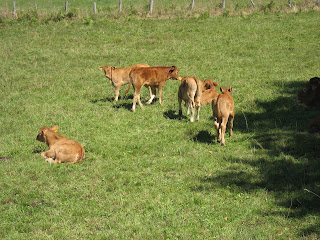Look spiffy, girls. We're gonna be *STARS*
The Salers [pronounced Sal (as in my gal Sal) airss] is a breed of cattle which originated in Cantal in the Massif Central of France.
There is a commune in the Corrèze area called "Millevaches" (Thousand Cows); I can understand how it got its name!
They are a large breed, with the female weighing between 700 and 750 kg (1,543 to 1,653 lb) and standing 1.40 metres (4.6 feet) tall. They have a thick mahogany red or black coat, and long, lyre-shaped, light-coloured horns. A small percentage are naturally born without horns (polled).
Are you getting my best side?
Originally bred for work, this cow was especially appreciated for its ability to withstand extreme variations in temperature, its fertility, its ease of breeding, its milk (even if the presence of the calf was required in order to milk it) and its meat.
In Cantal, the farmers practise mountain pasture, with the herd passing summer at altitude in the mountains.
A female can produce almost 3,000 kg (6,614 lb) of fat-rich milk each year of her life. The milk is traditionally used to produce Appellation d'Origine Contrôlée (AOC) cheese such as Cantal and Salers cheese. The Salers is also used to produce veal calves by cross breeding with Charolais cattle.
The Salers female displays exceptional maternal qualities of fertility, milking ability, calving ease, hardiness and longevity. High percentage calf crops resulting from the inherent fertility of Salers are realised through early puberty, quick rebreeding and high conception rates coupled with the breed's predictable calving ease and large pelvic structure.
Further maternal advantage is realised through the Salers ability to wean a heavy calf while taking care of herself. More kilograms at weaning result from the combination of good lactation and lean growth factors.
Bulls are known for their ability to cover large numbers of females and in the ranching countries bull numbers have been halved and calving percentages have risen, another valuable saving on herd costs.
The Salers influence contributes a large pelvic area to cross bred replacement females and will allow commercial suckler farmers to utilise heavily muscled terminal sires in a cross breeding programme with less concern about calving difficulties.
"My harem", bellows the bull.
***
It would be difficult to find a postcard representative of this region without a picture of the Salers cattle or cheese.
"Le Salers" is a French semi-hard cheese from the volcanic region in the mountains of Auvergne, central France. It is a pressed, uncooked cheese made from Salers cow's milk between the 15 April and 15 November. It is similar to Cantal cheese - which is produced from the same cows' milk when they are fed on hay during the remaining months of the year - and has been estimated to have been fabricated in this region for at least 2000 years.
Salers cheese
***
Salers Gentiane
Salers is another venerable French apéritif, made from gentian root and white wine. The flavor is bitter, but the bitterness is balanced with sweetness from the wine and other botanical flavorings. You may find that Salers is a bit of an acquired taste. It has a bold flavor, with vegetal notes and a bit of a rooty finish.
Salers is delicious served over ice, or topped with soda, but it's also good in cocktails.
***























Charolais has been my favourite breed for many years. I didn't know about Salers. What magnificent animals! Given their adaptability, we may need more of them to help humans cope with climate change. This is a terrific post! Margi
ReplyDeleteThey are magnificent, although I still think the cows from Normandy are "prettier" with their eye shadow and long eyelashes. The Salers seem to be the sturdy ones that are real survivors.
Delete